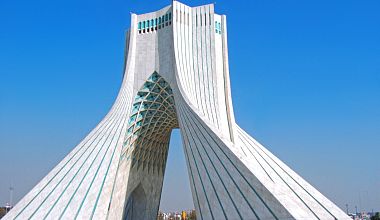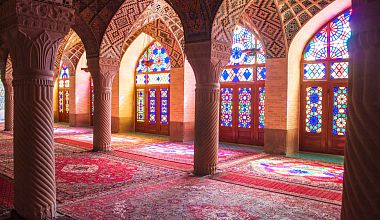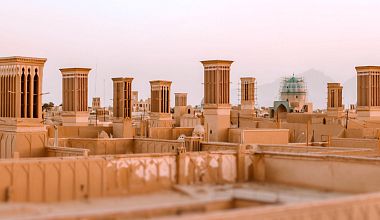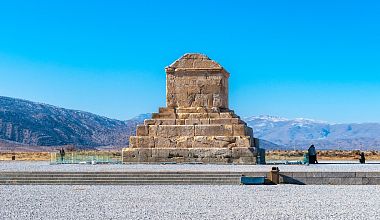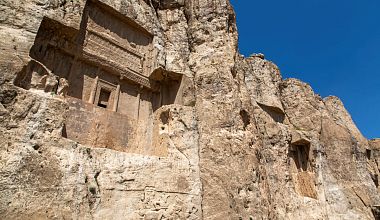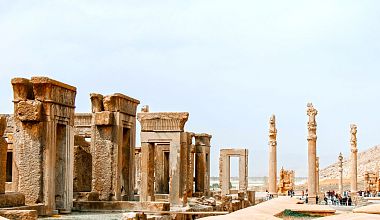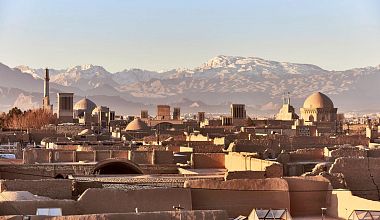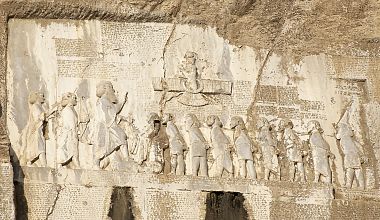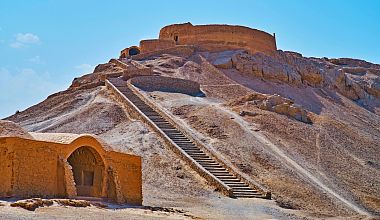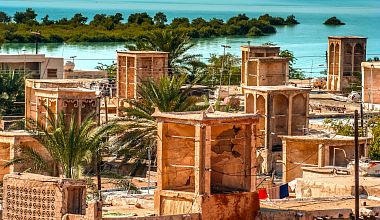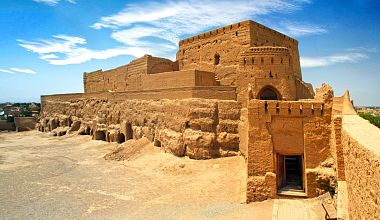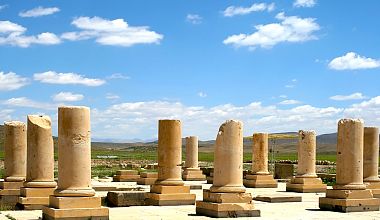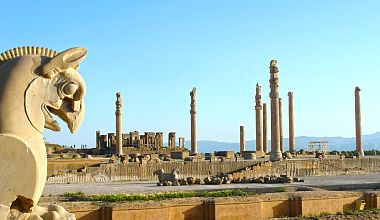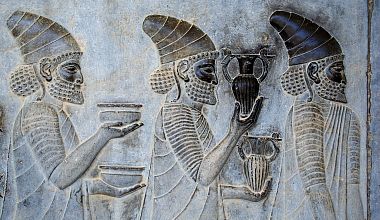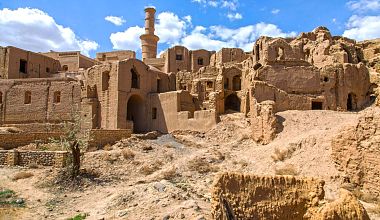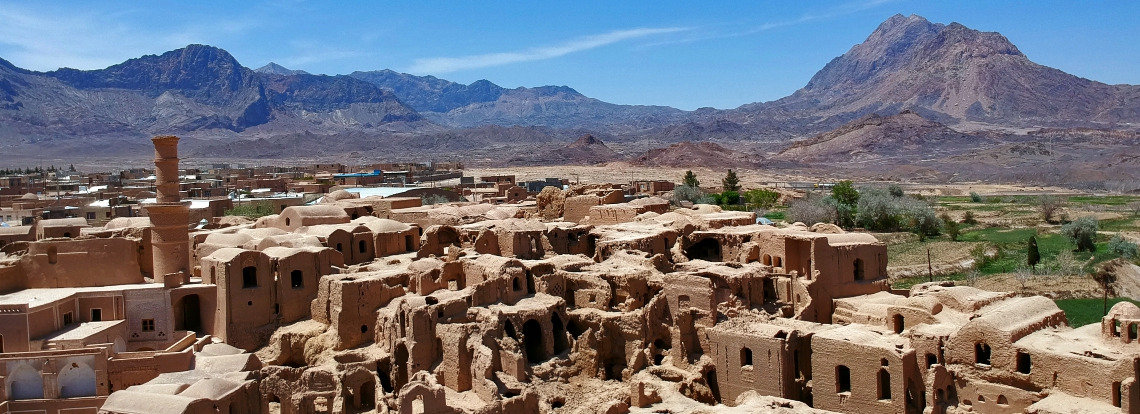
Reasons to go on a group tour in Iran
- to visit 20 cultural heritage and natural sites included on the UNESCO World Heritage list;
- to observe the cycles of the rise and fall of empires and civilisations;
- to see how the traditional art of a conquered people merged with that of the victors to create a new and distinct historic image of the conquerors;
- to explore how and why events from past centuries are reflected in modern media;
- to unravel the mysteries of one of the world's most enigmatic countries.
On the group tour to Iran we will
- explore the ancient standards of female beauty by studying figurines created during the 6th to 4th centuries BC;
- discover the purpose of the majestic ziggurats of Elam;
- read the cuneiform inscriptions of Darius I, carved on cliff at the Mount Behistun 2500 years ago;
- walk the path of kings and ambassadors through the ruins of ancient Persepolis, destroyed by Alexander the Great;
- discuss how the Zoroastrian teachings about good thoughts, good words, and good deeds shaped the principles of state and political governance in the multicultural Achaemenid Empire;
- compare the scale and architecture of the tombs of Cyrus the Great, Avicenna, Hafez, and Imam Khomeini;
- read aloud lines from Saadi’s poem "Gulistan", which were embroidered in gold letters on the handmade Persian carpet that adorns the wall in the UN headquarters, above the tomb of this remarkable poet;
- find out what elements of European architecture, borrowed during the reign of the Qajar dynasty, blended seamlessly into the interiors of mosques and houses of Iranian nobility;
- admire the beauty of the night sky on the edge of the Dasht-e Kavir desert.
Sightseeing tour of the cultural capital – the National Museum of Iran, the Milad Tower
Upon arrival, the guide will meet you at the airport. Your journey through Iran begins with a visit to the Mausoleum of Imam Khomeini. Although this landmark is not included on the UNESCO list, it is regarded as a key starting point for understanding the official ideology of modern Iran.
After checking in to the hotel and enjoying a brief rest, you will visit the National Museum of Iran. The complex consists of two sections: the Museum of Ancient Iran and the Museum of Islamic Archaeology and Art of Iran.
Here, you will discover an extraordinary collection of artefacts dating back to the 6th century BC, originating from Persepolis, Susa, and other ancient cities of the Persian Empire.
In the evening, you will savour an exquisite dinner at one of the fine restaurants located in the Milad Tower.
The National Museum of Iran. The Golestan Palace (the Rose Garden Palace). The ancient capital of Media.
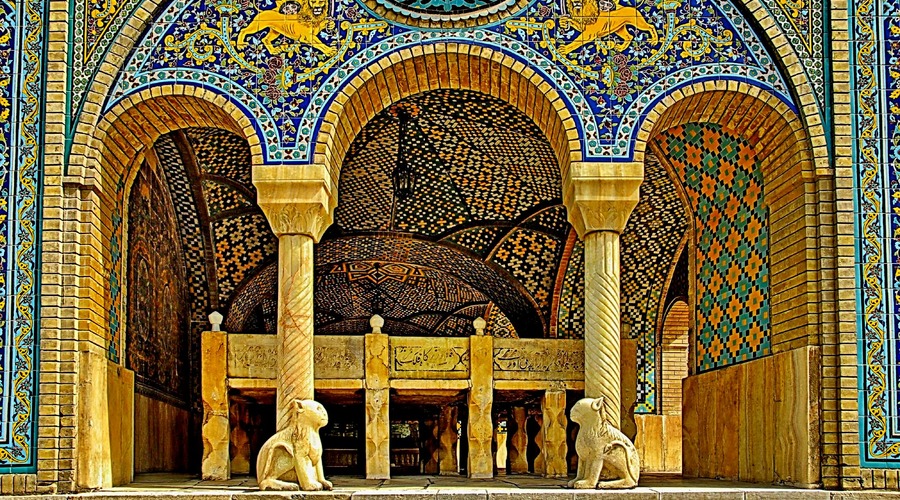
This day begins with a tour of the Shah’s Golestan Palace. The name of this site translates from Persian as the “Rose Garden Palace”. Now a museum complex open to visitors, it is located near the National Museum of Iran. Built in the 16th century during the Safavid dynasty, the Golestan Palace acquired its distinctive luxury much later, during the Qajar era (1795–1925).
Over the course of the tour, you will be immersed in the history of Persia in the 18th and 20th centuries, exploring the influence of the Qajar and Pahlavi dynasties on the “Rose Garden Palace”. You will also learn about the impact of Western powers on historical events, including the confrontation between Russia and Britain.
Following a brief break, you will depart for Ali Sadr province.
Exploring Ali Sadr Cave by boat. Departure for the ancient capital of Media — Ecbatana, now known as Hamadan. It became part of the Persian Empire when Cyrus the Great conquered the kingdom of Media. The tour of the city.
After breakfast, you will travel to Ali Sadr Cave — one of the largest in Iran, featuring numerous lakes, the deepest of which measures 15 metres in depth. The boat tour through the hanging stalactites will be a memorable addition to your exploration of Iran. Upon arriving in Hamadan and having a short break, you will embark on a city tour. Your acquaintance with the capital of the Medes begins with a visit to the site where the palace of Darius I once stood. The guide will provide insight into the history of Media and its people, the Persian conquest of the kingdom, and the Medes' contributions to its cultural development.
Later the same day, you will visit the Mausoleum of Avicenna and delve into the life of this great scientist, who made significant contributions to medicine and other sciences. A museum at the mausoleum showcases ancient medical equipment used by Avicenna, medicines he invented, and his personal belongings.
Another famous landmark near the Mausoleum of Avicenna is the Tomb of Esther and Mordechai. One of the books in the Bible is dedicated to Jewish Queen Esther, who, as a wise ruler, became the saviour of the Jewish people. The guide will recount the story of this remarkable rescue in detail during your visit to the tomb.
Departure for Kermanshah. Visit to the Behistun Inscription and the Statue of Heracles.
Leaving Hamadan early in the morning, you will travel to the city of Kermanshah.
Artefacts discovered near the city by Iranian and British scientists provide evidence of human habitation in the Kermanshah region as early as 12000 years ago. The road from Ecbatana to Mesopotamia ran through Kermanshah, and it was along this route that the great Persian king Darius I ordered an inscription to be carved on a rock known as Bisetun (translated from ancient Persian as "Place of Gods").
The guide will explain the message conveyed by the Behistun Inscription, how scientists deciphered it, and why this ancient monument of writing was included on the UNESCO World Heritage List.
To the right of the inscription stands the Statue of Heracles, which dates back to the Parthian period (2nd century BC). It is believed that the Parthians placed the statue of this Greek demi-god near the road to appeal to Greek merchants.
Kermanshah and Taq-e Bostan
Kermanshah served as one of the capitals of the Sassanid Empire (3rd–7th centuries). The Taq-e Bostan monument, located to the northeast of the city, dates back to their reign. It comprises of two grottoes and rock carvings depicting the coronation of Shapur III and the fall of the Parthian Empire.
Following the tour of Kermanshah, you will travel to the city of Dezful for the night.
Introduction to the architecture of Mesopotamia. The temple complex of Dur-Untash. Overnight in Ahvaz.
Early in the morning, your tour of Iran will continue in the ancient city of Susa.
Throughout its history, Susa witnessed the rise and fall of numerous civilisations. From the late 5th millennium BC to the 13th century AD, it was continuously inhabited by urban settlements that succeeded one another. Susa bears exceptional testimony to the cultural traditions of the Elamite, Persian, and Parthian eras, many of which have largely disappeared. This unique city has been added to the UNESCO World Heritage List.
The ruins of Susa, once the capital of the Persian Empire, and the remains of the palace of Darius I both illustrate the former grandeur and splendour of Persia. The guide will help to reconstruct an image of the ancient city by detailing its historical purpose, its lost traditions, and its half forgotten customs, as well as the civilisation of ancient Elam.
Nearby stands a relatively new structure for such an ancient site – the Morgan’s Fortress. Built by French archaeologists during their excavations to protect against raids, the fortress now houses an archaeological museum, which you will visit following the city tour.
Further along the route lies another significant ancient site, founded in 1250 BC – Dur-Untash.
The city of Dur-Untash and the ziggurat of Chogha Zanbil, was left incomplete after the invasion of Ashurbanipal, King of Assyria. Around the ziggurat, thousands of unused bricks remain scattered at the construction site. Some of the bricks that were once at this site were later removed and used in the construction of Morgan’s Fortress.
The study of the ziggurat and the wider archaeological site of Chogha Zanbil, which includes other temples, residential buildings, tomb palaces, and reservoirs, has provided valuable insights into the architecture of the Elamite period. The ruins of Susa and Chogha Zanbil stand as the only evidence of the architectural advancements of the Middle Elamite period (1400–1100 BC).
Not far from Dur-Untash lies the Shushtar Historical Hydraulic System, another remarkable ancient landmark of Iran. Founded in the 5th century BC, it is considered an engineering and creative masterpiece.
This complex structure demonstrates the expertise of the Elamites and the Mesopotamians, as well as the influence of Roman construction techniques on Persian engineering. For its historical significance, it was added to the UNESCO World Heritage List in 2009.
In the evening, you will travel to the city of Ahvaz for an overnight stay.
Departure for Shiraz
After breakfast, you will depart for the city of Shiraz. Along the way, you will enjoy magnificent landscapes, including mountains, forests, and waterfalls, as well as visit the city of Kazerun and the Statue of Shapur.
The sightseeing tour of Shiraz
Shiraz has long been renowned as a centre for winemaking, even before the era of the Islamic Revolution. According to one local tradition, the world-famous Syrah or Shiraz grape variety originated in this region and was later introduced to France, where it gained international acclaim.
On this day, you will explore the main attractions of Shiraz. Among them is the Nasir al-Mulk Mosque, celebrated for its unique design. The mosque features sublime stained-glass windows in a multitude of colours. Early in the morning or at sunset, a mesmerising phenomenon occurs as sunlight streams through the windows, creating intricate patterns of vibrant colours on carpets, walls, and even faces of visitors.
Another notable place to visit is the Ali Ibn Hamzeh Holy Shrine which is an outstanding example of mirror mosaic art. The interior is adorned with countless small mirror pieces that dazzle like diamonds in their brilliance.
Then there is the masterpiece of human creative genius, Eram Garden, included on the UNESCO World Heritage List in 2011. The design of the Persian garden, characterised by its geometric proportions and division into four parts, exemplifies advanced engineering and innovative water management systems. The garden’s layout and carefully planned flora evoke the idea of an earthly paradise, standing in stark contrast to the surrounding desert landscape.
One must not forget the Tomb of Hafez, a serene and majestic spot where the spirit of the celebrated poet lives on through the recital of his poetry near his final resting place.
The Arg of Karim Khan, once the residence of Karim Khan Zand — a prominent ruler who declared Shiraz the capital of Persia in 1766 — is another attraction.
And nearby, you will find the Vakil Mosque and Bazaar. Constructed in the 18th century as the principal mosque of the nation during Shiraz’s time as the capital, the Vakil Mosque is breathtaking both inside and out and is well worth a visit.
Ancient capitals of the Persian Empire
Begin your day with an introduction to the ancient capitals of the Persian Empire. After breakfast, you will depart for Persepolis, a UNESCO World Heritage Site.
Persepolis is an extraordinary ensemble of grand entrances, monumental staircases, throne rooms (such as the Apadana), reception halls, and auxiliary buildings. This iconic site is one of the world’s most remarkable archaeological treasures, unparalleled in its grandeur and a testament to the sophistication of one of the world’s earliest civilisations.
The city of Pasargadae represents the first exceptional example of royal Achaemenid architecture. Built under the direction of Cyrus the Great, it was the first capital of the Persian Empire and a product of collaboration among the various peoples unified under his rule. The vast Achaemenid Empire, which stretched from the eastern Mediterranean and Egypt to the Indus River in India, is renowned as the first empire to embrace and respect the cultural diversity of its peoples. This principle is vividly reflected in its architectural style, which synthesised elements from the cultures of conquered lands. The structures of Pasargadae illustrate the initial stage of this architectural evolution, which found its full expression in the construction of Persepolis.
After exploring these historic sites, you will travel to Yazd, an ancient city known as the centre of Zoroastrianism.
Introduction to Zoroastrian culture and religion. Visit to the Fire Temple and the Tower of Silence in Yazd. A sightseeing tour of Haranak.
Yazd is one of the oldest cities in the world. Built from clay and surrounded by desert, Yazd is the centre of Zoroastrianism, the ancient religion practised in Persia until the Arab conquest in the 7th century.
You will immerse yourself in the spirit of Zoroastrian culture by visiting the Temple of Fire and the Tower of Silence, a traditional mortuary structure. The guide will introduce you to the fundamental principles of this religion, many of which were later adopted by Islam, Judaism, and Christianity. You will also learn about Zoroastrian rituals, customs, and the remarkable preservation of their traditions over the centuries.
After lunch, you will explore the ghost town of Haranak.
Departure for Isfahan. The Naryn Castle. A sightseeing tour of the city
On your journey to Isfahan, you will visit the historic Naryn Castle and a traditional pigeon tower.
In the evening, you will take a stroll to the iconic Si-o-se-pol and Khaju Bridges, admired for their stunning architecture and historical significance.
The sights of Isfahan. Departure for the Dasht-e Kavir desert. Overnight at the Matinabad Eco-Camp.
Your day will begin at a time convenient for you and with a visit to Isfahan’s most renowned attraction — Naqsh-e Jahan Square (also known as Shah Square).
Constructed in the early 17th century, the square is a masterpiece of urban architecture, featuring the Shah Mosque, the Sheikh Lotfollah Mosque, the Ali Qapu Palace, and a shopping arcade.
The Shah Mosque, renamed the Imam Mosque after the Islamic Revolution, is particularly noteworthy. Built in the 17th century by order of Shah Abbas the Great, the mosque’s structure is crowned with a double-layer dome and adorned with glazed tiles in shades of turquoise, light blue, and navy. Two towering minarets, each nearly 42 metres high, flank the mosque’s entrance.
Adjacent to the Shah Mosque stands the Ali Qapu Palace, the former residence of Shah Abbas.
After exploring Naqsh-e Jahan Square, you will visit the Sheikh Lotfollah Mosque.
During the tour, the guide will elaborate on the life and achievements of Shah Abbas, his significant contributions to the development of Iran, and the enduring impact of his reign on the country’s modern history. You will also learn about the resettlement of Armenians in Isfahan and how the Orthodox faith continues to coexist harmoniously within an Islamic society.
In the evening, you will travel to the Matinabad Desert Eco-Camp, a perfect place for relaxation, enjoying the tranquillity of the desert, and stargazing under clear skies.
A walk through Abyaneh village. Departure for Kashan.
After breakfast, featuring locally made cuisine, you will travel to the city of Kashan.
On the way, you will visit the historic village of Abyaneh. This village is renowned not only for its unique architecture, with houses built from red clay, but also for its distinct local culture and customs, which differ significantly from those in central Iran.
Since ancient times, Kashan has been situated at the crossroads of major trade routes. Caravans, weary from long journeys, would first head to the Persian bathhouses. These bathhouses were not only places of rest but also venues for socialising, negotiating, and conducting business. One such place is the Sultan Amir Ahmad Bathhouse, where your tour of Kashan will begin. This historic hammam is adorned with mosaics and murals so exquisite that they rival the decorations of royal palaces.
After exploring the main attractions of Kashan, you will visit a local rose water production site. Rose water is traditionally made from damask roses, which are harvested in Iran from 22 April to 22 May.
The sights of Kashan. Departure for Tehran.
On this day, you will visit the Sultan Amir Ahmad Bathhouse and a historic house-museum that once belonged to a wealthy carpet merchant. You will also explore the Fin Garden, the oldest extant garden in Iran.
After completing your sightseeing in Kashan, you will travel to Tehran, where you will stay at a hotel near the airport, avoiding the capital’s traffic congestion.
Departure for home with delightful memories of your journey
- Tehran
- Kashan
- Isfahan
- Abyaneh village
- Yazd
- Shiraz
- Susa
- Shushtar
- Hamadan
- Behistun Inscription
- Alisadr Cave
- Milad Tower
- Golestan Palace
- Treasury of National Jewels
- Mausoleum of Ruhollah Khomeini
- Azadi Tower
- Fin Garden
- Agha Bozorg Mosque
- Sultan Amir Ahmad Bathhouse
- Nushabad Underground City
- Bazaar of Kashan
- Abouzeid Abad Desert
- Naqsh-e Jahan Square
- Sheikh Lotfollah Mosque
- Si-o-Se Pol Bridge
- Khaju Bridge
- Chehel Sotoun Palace
- Vank Cathedral
- Jameh Mosque of Isfahan
- Yazd Tower of Silence
- Zoroastrian Fire Temple of Yazd (Atashkadeh-e Yazd)
- Kharanaq Village
- Persepolis (Takht-e Jamshid)
- Pasargadae
- Nasir al-Mulk Mosque
- Naqsh-e Rostam
- Shah Cheragh Shrine
- Arg of Karim Khan
- Tomb of Hafez
- Eram Garden
- Maharloo Lake
- English speaking guide
- Transfer
- Accommodation in a 3-4 star hotel
- Driver escort
- Travel insurance
- Iranian visa
- Entry tickets
- International flights
- Lunches and dinners
- Souvenirs

